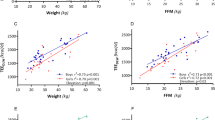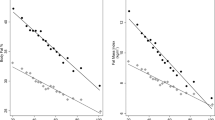Abstract
OBJECTIVE: To investigate the controversy regarding the means of adjusting the energy cost of physical activity measured by doubly labeled water for differences in body size.
DESIGN: We performed a cross-sectional study of the energy costs of carefully reproduced light activities with careful control for fidgeting and other unnecessary movement.
SUBJECTS: The study was performed in 23 healthy, young to middle aged adults with body masses between 39 and 118 kg.
MEASUREMENTS: Energy expenditure was measured by respiratory gas exchange while subjects performed controlled light activities representative of activities of daily life. Body composition was measured by bioelectrical impedance analysis.
RESULTS: The energy costs of individual controlled light activities were proportional to body weight except for mock vacuum cleaning. When the energy costs of all five activities were taken together, allometric regression analysis indicated that the energy cost of these light activities was proportional to body weight (slope=0.88±0.07), but not to fat-free mass (1.24±0.10), fat mass (0.27±0.03) or resting metabolic rate (1.43±0.12).
CONCLUSION: Normalization of energy expenditure of physical activity by division by body weight is an appropriate means for comparing the volume (intensity×time) of physical activity between individuals of different body size.
This is a preview of subscription content, access via your institution
Access options
Subscribe to this journal
Receive 12 print issues and online access
$259.00 per year
only $21.58 per issue
Buy this article
- Purchase on Springer Link
- Instant access to full article PDF
Prices may be subject to local taxes which are calculated during checkout

Similar content being viewed by others
References
Schoeller DA, van Santen E . Measurement of energy expenditure in humans by doubly labeled water method J Appl Physiol 1983 53: 955–959.
Montoya HJ, Kemper HCG, Saris WHM, Washburn RA . Measuring physical activity and energy expenditure Human Kinetics: Champaign, IL 1996.
Black AF, Coward WA, Cole TJ, Prentice AM . Human energy expenditure in affluent societies: an analysis of 574 doubly-labelled water measurements Eur J Clin Nutr 1996 50: 72–92.
Ravussin E, Swinburn BA . Metabolic predictors of obesity: cross-sectional versus longitudinal data Int J Obes Relat Metab Disord 1993 17(Suppl 3): S28–S31.
Reed GW, Hill JO . Measuring the thermic effect of food Am J Clin Nutr 1996 63: 164–169.
Diaz E, Goldberg GR, Taylor M, Savage JM, Sellen D, Coward WA, Prentice AM . Effects of dietary supplementation on work performance in Gambian laborers Am J Clin Nutr 1991 52: 803–811.
Bassett DR Jr, Nagle FN . Energy metabolism in exercise and training. In: Wolinski I, Hickso JF Jr (eds). Nutrition in exercise and sport, 2nd edn. CRC Press: Boca Raton, FL 1994 139–158.
Esparza J, Fox C, Harper IT, Bennett PH, Schulz LO, Valencia ME, Ravussin E . Daily energy expenditure in Mexican and USA Pima Indians: low physical activity as a possible cause of obesity Int J Obes Relat Metab Disord 2000 24: 55–59.
Schoeller DA, Shay K, Kushner RF . How much physical activity is needed to minimize weight gain in previously obese women? Am J Clin Nutr 1997 66: 551–556.
Prentice AM, Goldberg GR, Murgatroyd PR, Cole TG . Physical activity and obesity: problems in correcting expenditure for body size Int J Obes Relat Metab Disord 1996 20: 688–691.
Allison DB, Paulre F, Goran MI, Poehlman ET, Heymsfield SB . Statistical considerations regarding the use ratios to adjust data Int J Obes Relat Metab Disord 1995 19: 644–652.
Goran MI . Variation in total energy expenditure in humans Obes Res 1995 3: 59–66.
Blair SN, Haskell WL, Ho P, Paffenbarger RS Jr, Vranizan KM, Farquhar JW, Wood PD . Assessment of habitual physical activity by a seven-day recall in a community survey and controlled experiment Am J Epidemiol 1985 122: 794–804.
Levine JA, Schleusner SJ, Jensen MD. Energy expenditure of nonexercise activity . Am J Clin Nutr 2000 72: 1451–1454.
Kushner RF, Schoeller DA, Fjeld CR, Danford LC . Is the impedance index H2/R important in predicting total body water? Am J Clin Nutr 1992 56: 835–839.
Pace N, Rathbun EN . Studies on body composition III: the body water and chemically combined nitrogen content in relation to fat content J Biol Chem 1945 158: 685–691.
Weir JB de V . New methods for calculating metabolic rate with special reference to protein metabolism J Physiol 1949 109: 1–9.
Petrie A, Sabin C . Medical statistics at a glance Blackwell Science: London; 2000 67–69.
Heitmann BL . Prediction of body water and fat in adult Danes from measurement of electrical impedance, a validation study Int J Obes 1990 14: 789–802.
Schoeller DA . Balancing energy expenditure and body weight Am J Clin Nutr 1998 68: 956S–961S.
Schulz Y, Weinsier RL, Hunter GR . Assessment of free-living physical activity in humans Obes Res 2001 9: 368–379.
Acknowledgements
We thank the nurses and staff of the GCRC for their help during these studies. We also thank KJ Shay for performing the measures of energy expenditure in the post-obese women. This study was supported by grants DK30031, DK26678 and RR00055.
Author information
Authors and Affiliations
Corresponding author
Rights and permissions
About this article
Cite this article
Schoeller, D., Jefford, G. Determinants of the energy costs of light activities: inferences for interpreting doubly labeled water data. Int J Obes 26, 97–101 (2002). https://doi.org/10.1038/sj.ijo.0801851
Received:
Revised:
Accepted:
Published:
Issue Date:
DOI: https://doi.org/10.1038/sj.ijo.0801851
Keywords
This article is cited by
-
Usefulness of motion sensors to estimate energy expenditure in children and adults: a narrative review of studies using DLW
European Journal of Clinical Nutrition (2017)
-
Physical Activity, Energy Expenditure, and Defense of Body Weight in Melanocortin 4 Receptor-Deficient Male Rats
Scientific Reports (2016)
-
A novel approach for measuring energy expenditure of a single sit-to-stand movement
European Journal of Applied Physiology (2016)
-
High energy expenditure masks low physical activity in obesity
International Journal of Obesity (2013)
-
Advances in physical activity monitoring and lifestyle interventions in obesity: a review
International Journal of Obesity (2012)



